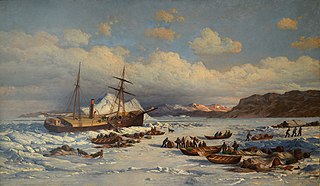 W
WThe Polaris expedition of 1871–1873 was one of the first serious attempts to reach the North Pole after that of British naval officer Sir Edward Parry, who reached 82° 45′ N in 1827. Funded by the U.S. government, the expedition's notable achievement was reaching 82° 29′ N by ship, a record at the time.
 W
WEmil Bessels was a German zoologist, entomologist, physician, and Arctic researcher who is best known for his controversial role in the attempted but ill-fated Polaris expedition to the North Pole in 1871. Circumstantial evidence strongly points to Bessels as the most likely suspect in the death of the expedition's commander, American explorer Charles Francis Hall, by arsenic poisoning.
 W
WCharles Francis Hall was an American Arctic explorer, best known for the suspicious circumstances surrounding his death while leading the American-sponsored Polaris expedition in an attempt to be the first to reach the North Pole. The expedition was marred by insubordination, incompetence, and poor leadership.
 W
WHans Hendrik was a Kalaallit interpreter, Arctic explorer, and the first Inuk to publish an account of his travels. He was born in the southern settlement of Fiskenæsset.
 W
WIpirvik was an Inuk guide and explorer who assisted several Arctic explorers, among them Charles Francis Hall and Frederick Schwatka. He and his wife Taqulittuq were the best-known and most widely-travelled Inuit in the 1860s and 1870s.
 W
WThe first USS Juniata was a sloop of war in the United States Navy during the American Civil War.
 W
WWilliam Frederick Carl Nindemann was a German-born American Arctic explorer and recipient of the Congressional Silver Jeannette Medal.
 W
WUSS Polaris, originally called the America, was an 1864-screw steamer procured by the Union Navy as USS Periwinkle during the final months of the American Civil War. She served the Union Navy's struggle against the Confederate States as a gunboat.
 W
WRavenscrag is the name of several ships, some being sailing vessels and some steamships. One of the sailing vessels is historically significant for bringing to the Hawaiian Islands in 1879 Portuguese immigrants who subsequently introduced the ukulele to island culture.
 W
WGeorge Maxwell Robeson was an American Republican Party politician and lawyer from New Jersey. A brigadier general in the New Jersey Militia during the American Civil War, he served as Secretary of the Navy, appointed by President Ulysses S. Grant, from 1869 to 1877. He also served two terms as a U.S. Representative for New Jersey from 1879 to 1883.
 W
WTaqulittuq was an Inuk interpreter and guide. She and her husband Ipirvik worked alongside Arctic explorer Charles Francis Hall and joined him in his search for Franklin's lost expedition in the 1860s, as well as the Polaris expedition to reach the North Pole
 W
WThe third USS Tigress was a screw steamer of the United States Navy, chartered during 1873 to mount an Arctic rescue mission.